
MARS STRANGE BIO-LIFE 3c
Report #148
October 5, 2008
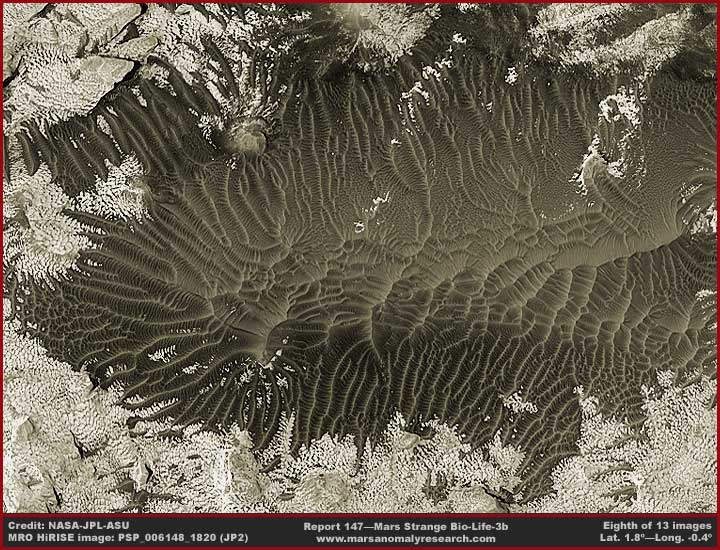
The above eighth image is a context wider-angle scene of one of the many smaller ridge form sites in this strip. Here we have a wider area context view of the entire site and the surrounding terrain it sits in. Now please note the extensive very light reflective evidence all around the darker color ridge form evidence and its texture pattern. This is also very densely packed new to our perception and enabled by the JP2 imaging bio-life of some different kind.
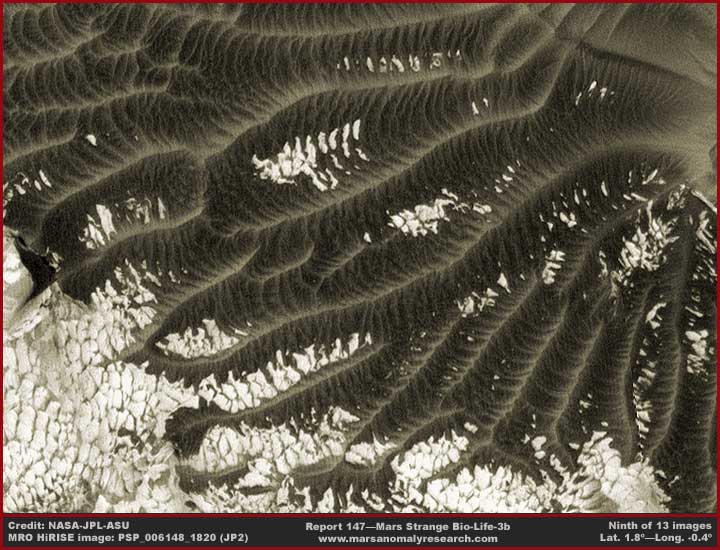
The above ninth image is very dramatic looking but the darker material is just the same ridge form bio-life evidence in the same form most often seen in this strip. This scene is from the lower left corner of the whole ridge form site as viewed in the previous eighth image. The ridges are like tentacles snaking out from the main core no doubt searching for more water presence. However, here their foraging outward is having to compete with a sea of some other kind of very light reflective bio-life characterized by the look of individually defined clumps.
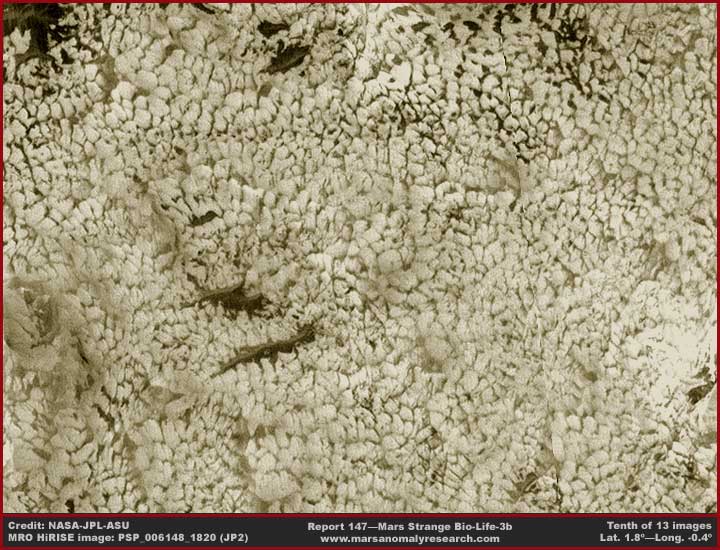
The above tenth image is of a scene
just below and adjacent to the darker color ridge form evidence in the 7th
and 8th images. As you can see, with the reflectivity subdued a bit, this
shows the very light reflective clump bio-life evidence a lot better. Note
how densely packed this growth is. This is the best and most telling view
of this type of bio-life evidence but it is plentiful all over this strip
and especially where the major ridge form sites are located around the strip.
This suggests that this evidence is competing with the ridge form evidence
for a surface water presence unseen under all this carpet of life. This is
not the first time that I have reported on this type of evidence. Take a look
at my Report 122 and
specifically the last two 8th and 9th images. In that report this type of
evidence (more distantly seen) is filling depressions with very densely packed
formations like the above on the South Polar ice cap where melt water is likely
to collect. That suggests that it is also very cold hardy as well as surface
water oriented.
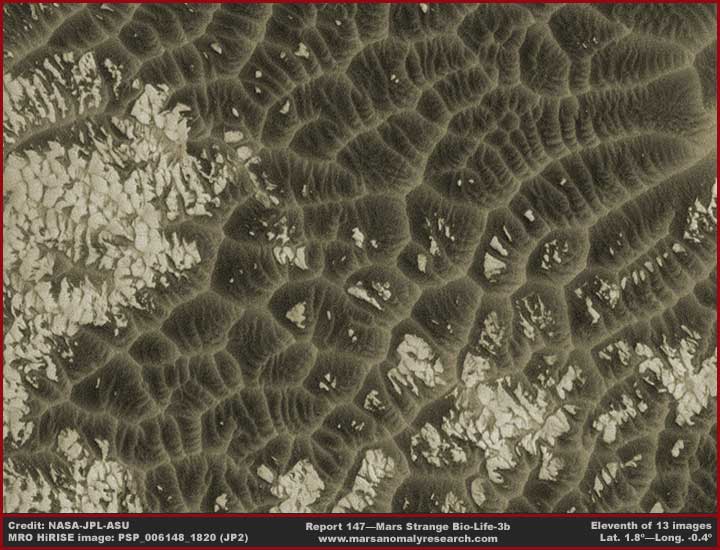
The above eleventh image is of another site in another part of the strip. I'm including this just to demonstrate that the darker ridge form evidence can take on a closed cell appearance among its branching's as well as show that the very light reflective evidence is usually present where ever the many ridge form sites are located. Although it certainly isn't conclusive, there is also some visual evidence here suggesting that the ridge form evidence may be riding over the top of the very light reflective clump evidence.
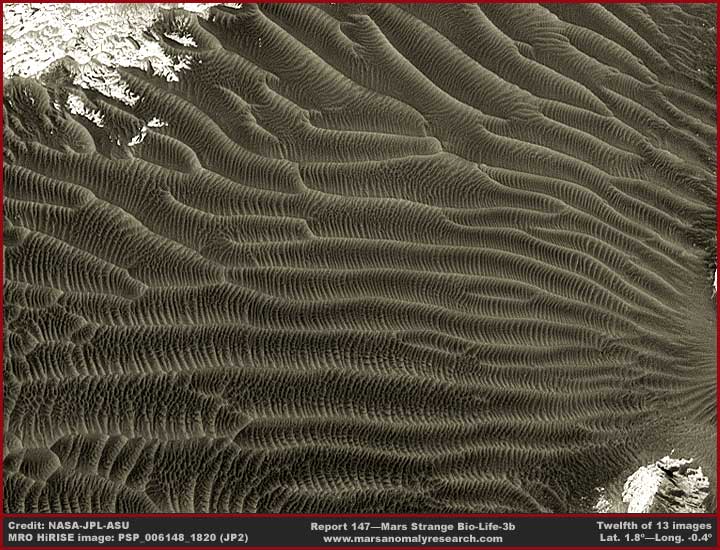
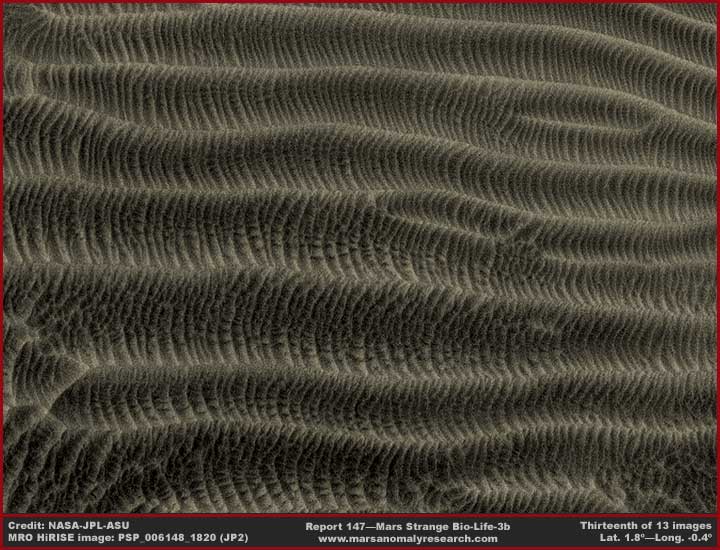
The above last two 12th and 13th
images show yet another different looking ridge form site in this strip. As
you can see these long lines are made up of a great many densely packed parallel
rib features laying 90º across a trough and rising up to a ridge peak.
However, the difference here is that the ridge peaks do not turn into smoother
material nearing the top because each rib extends all the way to the top forming
a very thin sharp ridge peak. Strange isn't it.
Here again some of you may be getting into this concave versus convex viewing
appearance problem. Note that the evidence in the near foreground of these
images consistently looks concave with the troughs between the ridges bowed
downward as we look a little more straight down on the evidence. However,
the evidence in the background begins to take on a convex illusion with the
troughs bowed upward as we look at it with a slightly more distant and oblique
angle.
Please now also take a closer look at some of the larger individual
ribs crossing the troughs in the above 12th and 13th images. Although small
here, note how they appear to be sectional down their length suggesting overlapping
joints. Now take a look at the evidence in Report
125 (Parts 2 & 3) posted a year ago. Yes that Report 125 evidence
is absolutely colossal in size compared to this but note the multiple very
similar overlapping joint composition that both may(?) share.
Obviously this evidence doesn't look all that much like the rest of the ridge
form evidence here in this report. Such visual differences are often explained
by different requirements in adapting to water presence. However, could the
12th and 13th image evidence actually be entirely different water presence
evidence and in some distant way related to the Report 125 colossal evidence?
If so, what kind of water presence implications does that have for the Report
125 evidence as to it being some colossal life form rather than geology?
The Report 125 colossal size evidence seems to be confined to the North Pole
where surface water is much more scarce than at the South Pole. Could it be
that the colossal evidence got so colossal in size by attaching themselves
to North Polar major water sources and feeding off of them continuously becoming
so bloated and immobile in the process like some increasingly gigantic hide
bound worm that has literally become part of the landscape and yet is still
alive?
Could this be the primary reason why there is so little or almost no visible
surface water in the North Polar area because what is available is being sucked
away into these colossal forms? It's admittedly a speculation stretch but
still a consideration that we should not ignore and keep an open mind about.
Meanwhile, you've had a pretty decent look at a variety of what I call "ridge
form" evidence and now also the very light reflective clump looking evidence.
Even though the evidence here may be fantastic looking, it is something real
in our solar system. In light of what you've seen here, can you really buy
into the official geological narrative explanation found HERE?
Does any of this evidence look like geology to you?
One has to again wonder why the news media doesn't lock onto this type of
strange and fantastic looking evidence and present it to their viewers. Surely,
regardless of interpretation as to what it is, there should be no question
that the mainstream public they serve would be very interested in such visuals.
If that doesn't happen voluntarily, what does that say about the media? Could
it be that any examination of this evidence that is too close in detail would
suggest life rather than inanimate geology?
DOCUMENTATION
http://hirise.lpl.arizona.edu/PSP_006148_1820:
This link takes you to the official MRO HiRISE PSP_006148_1820
science data strip for both the browser compatible .jpg imaging used in my
previous Report 147 and the not browser compatible JP2 imaging used in this
report. The evidence here was drawn from the full grayscale map projected
image listed as 1410.3 MB in the "JP2 Products (download)" section
in the page right vertical column. For me in Windows, the image was 1.3 GB
and downloaded in about 1:45 minutes.
NOTE: Proprietary JPEG 2000 or JP2 images like this one are huge and will
require the free but specialized IAS Viewer and that will in turn require
the presence of updated JAVA on your system. The IAS Viewer program auto installer
requires JAVA in order to do the install properly. JAVA is free at www.java.com
and the free IAS Viewer is available at http://hirise.lpl.arizona.edu/jp2.php.
, Investigator
![]()